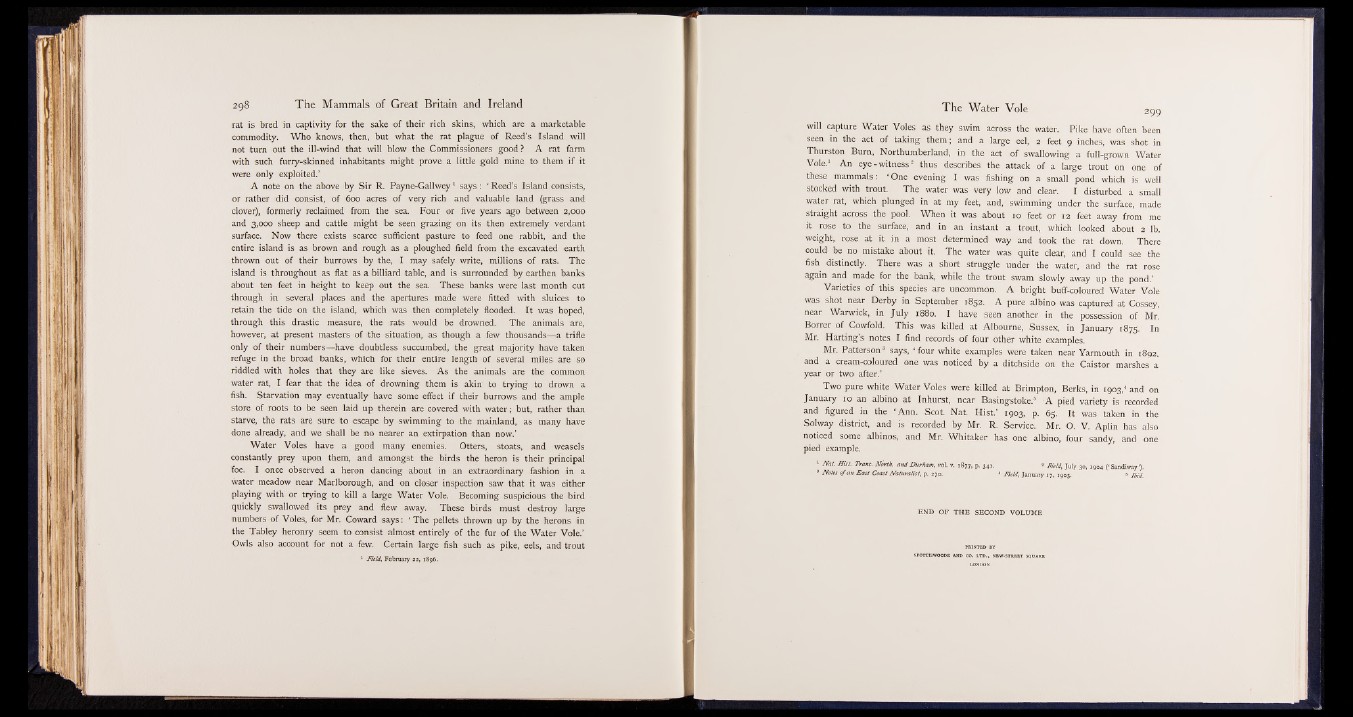
rat is bred in captivity for the sake of their rich skins, which are a marketable
commodity. Who knows, then, but what the rat plague of Reed’s Island will
not turn out the ill-wind that will blow the Commissioners good ? A rat farm
with such furry-skinned inhabitants might prove a little gold mine to them if it
were only exploited.’
A note on the above by Sir R. Payne-Gallwey1 says : ‘ Reed’s Island consists,
or rather did consist, of 600 acres of very rich and valuable land (grass and
clover), formerly reclaimed from the sea. Four or five years ago between 2,000
and 3,000 sheep and cattle might be seen grazing on its then extremely verdant
surface. Now there exists scarce sufficient pasture to feed one rabbit, and the
entire island is as brown and rough as a ploughed field from the excavated earth
thrown out of their burrows by the, I may safely write, millions of rats. The
island is throughout as flat as a billiard table, and is surrounded by earthen banks
about ten feet in height to keep out the sea. These banks were last month cut
through in several places and the apertures made were fitted with sluices to
retain the tide on the island, which was then completely flooded. It was hoped,
through this drastic measure, the rats would be drowned. The animals are,
however, at present masters of the situation, as though a few thousands—a trifle
only of their numbers—have doubtless succumbed, the great majority have taken
refuge in the broad banks, which for their entire length of several miles are so
riddled with holes that they are like sieves. As the animals are the common
water rat, I fear that the idea of drowning them is akin to trying to drown a
fish. Starvation may eventually have some effect if their burrows and the ample
store of roots to be seen laid up therein are covered with water; but, rather than
starve, the rats are sure to escape by swimming to the mainland, as many have
done already, and we shall be no nearer an extirpation than now.’
Water Voles have a good many enemies. Otters, stoats, and weasels
constantly prey upon them, and amongst the birds the heron is their principal
foe. I once observed a heron dancing about in an extraordinary fashion in a
water meadow near Marlborough, and on closer inspection saw that it was either
playing with or trying to kill a large Water Vole. Becoming suspicious the bird
quickly swallowed its prey and flew away. These birds must destroy large
numbers of Voles, for Mr. Coward says: ‘ The pellets thrown up by the herons in
the Tabley heronry seem to consist almost entirely of the fur of the Water Vole.’
Owls also account for not a few. Certain large fish such as pike, eels, and trout
1 Field, February 22, 1896.
will capture Water Voles as they swim across the water. Pike have often been
seen in the act of taking them; and a large eel, 2 feet 9 inches, was shot in
Thurston Burn, Northumberland, in the act of swallowing a full-grown Water
Vole.1 An eye-witness2 thus describes the attack of a large trout on one of
these mammals: 1 One evening I was fishing on a small pond which is well
stocked with trout. The water was very low and clear. I disturbed a small
water rat, which plunged in at my feet, and, swimming under the surface, made
straight across the pool. When it was about 10 feet or 12 feet away from me
it rose to the surface, and in an instant a trout, which looked about 2 lb.
weight, rose at it in a most determined way and took the rat down. There
could be no mistake about it. The water was quite clear, and I could see the
fish distinctly. There was a short struggle under the water, and the rat rose
again and made for the bank, while the trout swam slowly away up the pond.’
Varieties of this species are uncommon. A bright buff-coloured Water Vole
was shot near Derby in September 1852. A pure albino was captured at Cossey,
near Warwick, in Ju ly 1880. I have seen another in the possession of Mr.
Borrer of Cowfold. This was killed at Albourne, Sussex, in January 1875. In
Mr. Harting’s notes I find records of four other white examples.
Mr. Patterson8 says, 'four white examples, were taken near Yarmouth in 1892,
and a cream-coloured one was noticed by a ditchside on the Caistor marshes a
year or two after.’
Two pure white Water Voles were killed at Brimpton, Berks, in 1903,4 and on
January 10 an albino at Inhurst, near Basingstoke.8 A pied variety is recorded
and figured in the 'Ann. Scot. Nat. Hist.’ 1903. P- 65. It was taken in the
Solway district, and is recorded by Mr. R. Service. Mr. O. V. Aplin has also
noticed some albinos, and Mr. Whitaker has one albino, four sandy, and one
pied example.
1 N at Hist. Tram. North, and Durham, vol. v. 1877, p. 341. s Field, July 30, 1904 (< Sandiway *).
a Notts o f an East Coast Naturalist, p. 170. ' Field. January .7, 1903 . * I6id.
END OF TH E SECOND VOLUME
PRINTED BY
SPOTTISWOODE AND CO. LTD., NBW-STRBBT SQUARE
LONDON